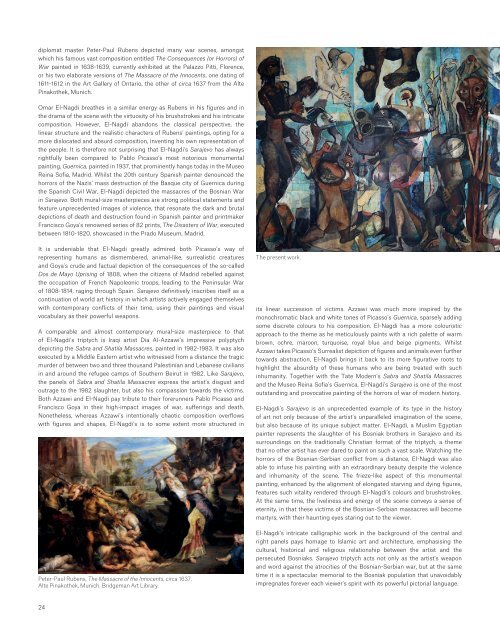NOW AND TEN
DUB1241_SaleCat
DUB1241_SaleCat
You also want an ePaper? Increase the reach of your titles
YUMPU automatically turns print PDFs into web optimized ePapers that Google loves.
diplomat master Peter-Paul Rubens depicted many war scenes, amongst<br />
which his famous vast composition entitled The Consequences (or Horrors) of<br />
War painted in 1638-1639, currently exhibited at the Palazzo Pitti, Florence,<br />
or his two elaborate versions of The Massacre of the Innocents, one dating of<br />
1611-1612 in the Art Gallery of Ontario, the other of circa 1637 from the Alte<br />
Pinakothek, Munich.<br />
Omar El-Nagdi breathes in a similar energy as Rubens in his fgures and in<br />
the drama of the scene with the virtuosity of his brushstrokes and his intricate<br />
composition. However, El-Nagdi abandons the classical perspective, the<br />
linear structure and the realistic characters of Rubens’ paintings, opting for a<br />
more dislocated and absurd composition, inventing his own representation of<br />
the people. It is therefore not surprising that El-Nagdi’s Sarajevo has always<br />
rightfully been compared to Pablo Picasso’s most notorious monumental<br />
painting, Guernica, painted in 1937, that prominently hangs today in the Museo<br />
Reina Sofa, Madrid. Whilst the 20th century Spanish painter denounced the<br />
horrors of the Nazis’ mass destruction of the Basque city of Guernica during<br />
the Spanish Civil War, El-Nagdi depicted the massacres of the Bosnian War<br />
in Sarajevo. Both mural-size masterpieces are strong political statements and<br />
feature unprecedented images of violence, that resonate the dark and brutal<br />
depictions of death and destruction found in Spanish painter and printmaker<br />
Francisco Goya’s renowned series of 82 prints, The Disasters of War, executed<br />
between 1810-1820, showcased in the Prado Museum, Madrid.<br />
It is undeniable that El-Nagdi greatly admired both Picasso’s way of<br />
representing humans as dismembered, animal-like, surrealistic creatures<br />
and Goya’s crude and factual depiction of the consequences of the so-called<br />
Dos de Mayo Uprising of 1808, when the citizens of Madrid rebelled against<br />
the occupation of French Napoleonic troops, leading to the Peninsular War<br />
of 1808-1814, raging through Spain. Sarajevo defnitively inscribes itself as a<br />
continuation of world art history in which artists actively engaged themselves<br />
with contemporary conficts of their time, using their paintings and visual<br />
vocabulary as their powerful weapons.<br />
A comparable and almost contemporary mural-size masterpiece to that<br />
of El-Nagdi’s triptych is Iraqi artist Dia Al-Azzawi’s impressive polyptych<br />
depicting the Sabra and Shatila Massacres, painted in 1982-1983. It was also<br />
executed by a Middle Eastern artist who witnessed from a distance the tragic<br />
murder of between two and three thousand Palestinian and Lebanese civilians<br />
in and around the refugee camps of Southern Beirut in 1982. Like Sarajevo,<br />
the panels of Sabra and Shatila Massacres express the artist’s disgust and<br />
outrage to the 1982 slaughter, but also his compassion towards the victims.<br />
Both Azzawi and El-Nagdi pay tribute to their forerunners Pablo Picasso and<br />
Francisco Goya in their high-impact images of war, suferings and death.<br />
Nonetheless, whereas Azzawi’s intentionally chaotic composition overfows<br />
with fgures and shapes, El-Nagdi’s is to some extent more structured in<br />
The present work.<br />
its linear succession of victims. Azzawi was much more inspired by the<br />
monochromatic black and white tones of Picasso’s Guernica, sparsely adding<br />
some discrete colours to his composition. El-Nagdi has a more colouristic<br />
approach to the theme as he meticulously paints with a rich palette of warm<br />
brown, ochre, maroon, turquoise, royal blue and beige pigments. Whilst<br />
Azzawi takes Picasso’s Surrealist depiction of fgures and animals even further<br />
towards abstraction, El-Nagdi brings it back to its more fgurative roots to<br />
highlight the absurdity of these humans who are being treated with such<br />
inhumanity. Together with the Tate Modern’s Sabra and Shatila Massacres<br />
and the Museo Reina Sofa’s Guernica, El-Nagdi’s Sarajevo is one of the most<br />
outstanding and provocative painting of the horrors of war of modern history.<br />
El-Nagdi’s Sarajevo is an unprecedented example of its type in the history<br />
of art not only because of the artist’s unparalleled imagination of the scene,<br />
but also because of its unique subject matter. El-Nagdi, a Muslim Egyptian<br />
painter represents the slaughter of his Bosniak brothers in Sarajevo and its<br />
surroundings on the traditionally Christian format of the triptych, a theme<br />
that no other artist has ever dared to paint on such a vast scale. Watching the<br />
horrors of the Bosnian-Serbian confict from a distance, El-Nagdi was also<br />
able to infuse his painting with an extraordinary beauty despite the violence<br />
and inhumanity of the scene. The frieze-like aspect of this monumental<br />
painting, enhanced by the alignment of elongated starving and dying fgures,<br />
features such vitality rendered through El-Nagdi’s colours and brushstrokes.<br />
At the same time, the liveliness and energy of the scene conveys a sense of<br />
eternity, in that these victims of the Bosnian-Serbian massacres will become<br />
martyrs, with their haunting eyes staring out to the viewer.<br />
Peter-Paul Rubens, The Massacre of the Innocents, circa 1637.<br />
Alte Pinakothek, Munich. Bridgeman Art Library.<br />
El-Nagdi’s intricate calligraphic work in the background of the central and<br />
right panels pays homage to Islamic art and architecture, emphasising the<br />
cultural, historical and religious relationship between the artist and the<br />
persecuted Bosniaks. Sarajevo triptych acts not only as the artist’s weapon<br />
and word against the atrocities of the Bosnian-Serbian war, but at the same<br />
time it is a spectacular memorial to the Bosniak population that unavoidably<br />
impregnates forever each viewer’s spirit with its powerful pictorial language.<br />
24


